My Singer book only briefly covers twin needle stitching so I found some additional internet resources as well.
- Sewing & Craft Alliance Guideline 11.227 Twin-Needle Sewing
- Julie Culshaw article at Timmel Fabrics
- Twin Needle Reference Chart by Carol Laflin-Ahles for Threads
- zigzag capability
- throat plate that has a hole wide enough for the double needle
- 2 thread spool holders
- zigzag foot or another foot with an opening wide enough for the twin needle
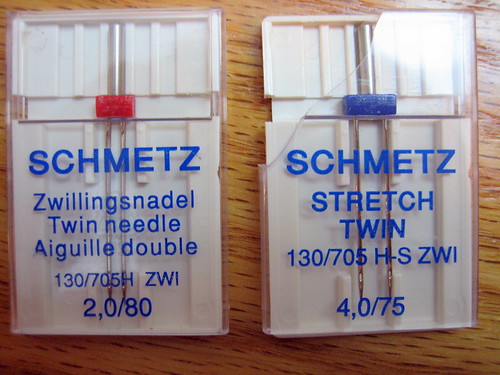
Twin needles come in different sizes like other needles but you will notice above that there are 2 numbers in the size.
- 1st number = distance between the needles (measured in millimeters--mm)
- 2nd number = actual size of the needles
Even though each needle will get its own thread, only one bobbin thread is used. One needle is slightly shorter than the other so a single bobbin can pick up both threads. In the picture below, the top needle is just slightly shorter.

The twin needles create 2 parallel lines of topstitching and a zigzag stitch on the underside. The zigzag stitch helps maintain the stretchability in a knit hem.
For my samples below, I used a total of 3 different colored threads. When I hemmed my knit cardigan, I wound a small amount of the matching thread around a 2nd bobbin. So I ended up with one thread spool and 2 bobbins with the same thread.
Parallel lines of topstitching
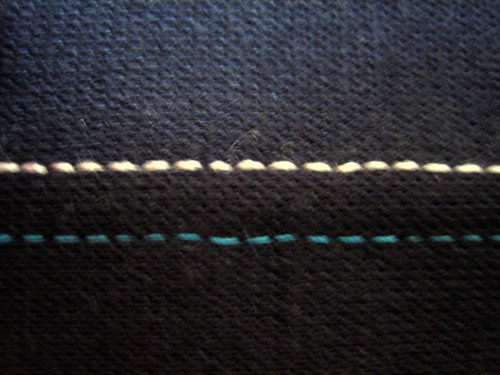
Zigzag stitching on the underside
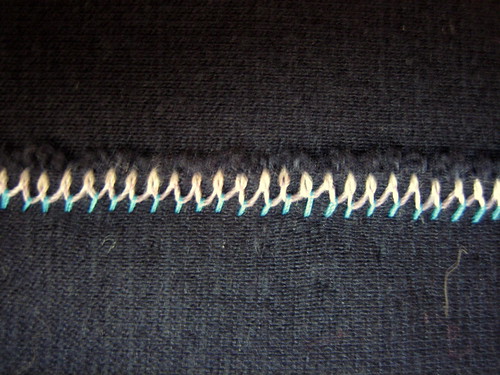
All the examples of twin needle stitching I could find showed a zigzag underside stitch where 2 different threads were visible. If your stitching looks like the above picture, you shouldn't need to adjust the tension.
The stitch:
- zigzag stitch should be selected
- stitch length = 2.5-3.0
- stitch width = 0.5
To prep the hem, fold over and iron your hem in place.
You are stitching on the RIGHT side of the fabric.
Because you are stitching on the right side of the fabric, it is very important that your folded over hem be even because you won't be able to see how close your stitches are to the raw edge. You will need to use your seam gauge on the throat plate or mark the throat plate with a piece of tape where your hem should hit so that the needles line up with the underside raw edge.
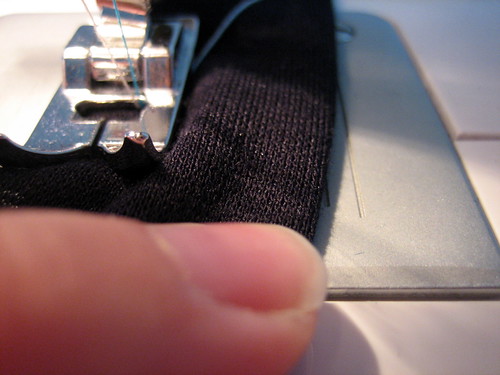
In the above picture, my 1-inch hem lined up perfectly with the last mark on the seam gauge on the throat plate.
If you notice sporadic bubbling in your topstitching, it probably isn't a tension problem (that would give you consistent bubbling). If you look at the zigzag underside of the fabric, you should see that your stitching is way past the raw edge of the hem in the areas of the bubbling. You just want the top row of stitches to catch as close as possible to the raw edge without going past it.
Look at the underside zigzag picture again.

The zigzag stitches aren't catching the raw edge, which is want you want. If it really bothers you, you can go back and trim it off. In my example above, I used scrap fabric and the raw edge is the "selvage."
Threading the needles:
Check your machine manual. Your machine may require that you separate the threads at the tension disks or thread guides. If you have a basic machine like mine, you can thread as follows.
Each needle gets its own thread spool on a different spool holder.
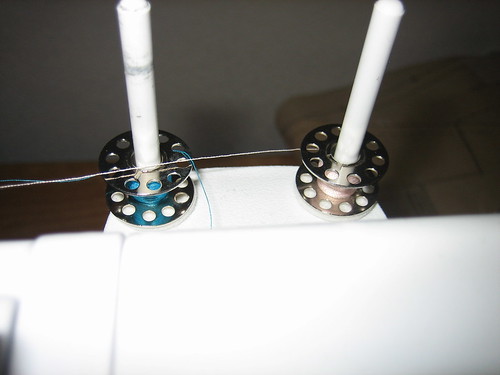
When I sewed, the 2 threads got twisted together at the needle but didn't mess up my stitching. If this is a problem for you, you can try Julie Culshaw's tip of threading one spool clockwise and the other counterclockwise so the threads come off in opposite directions.
I threaded both as one and didn't separate them until I got to the needles.


Look for my completed garment in a separate post later. Now that I know how to use twin needles, I can't wait to try some decorative stitching with it.
thanks for the detailed info!
ReplyDeleteI don't use double-needle stitching as often as I could, due to my lack of experience with it.
You really provided some good information on twin needles. I learned something here. Thanks for sharing.
ReplyDeleteYou are most welcome.
ReplyDeleteThank you so much, this is such a big help. I thought that you need a special sewing machine if you want to use a twin needle. I will definitely try this out!
ReplyDeleteThank you!
Thanks!!! This is wath I was looking for... ;)
ReplyDelete